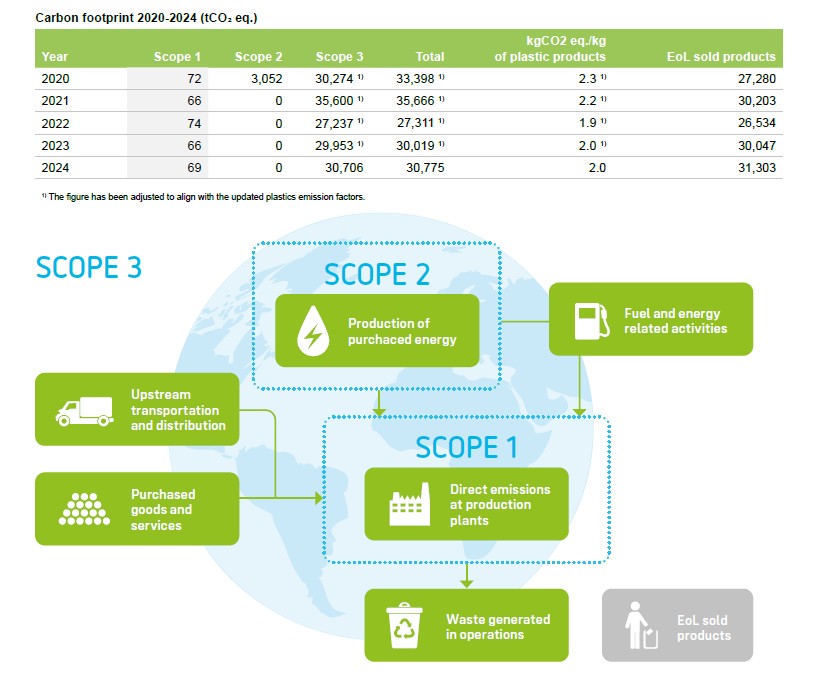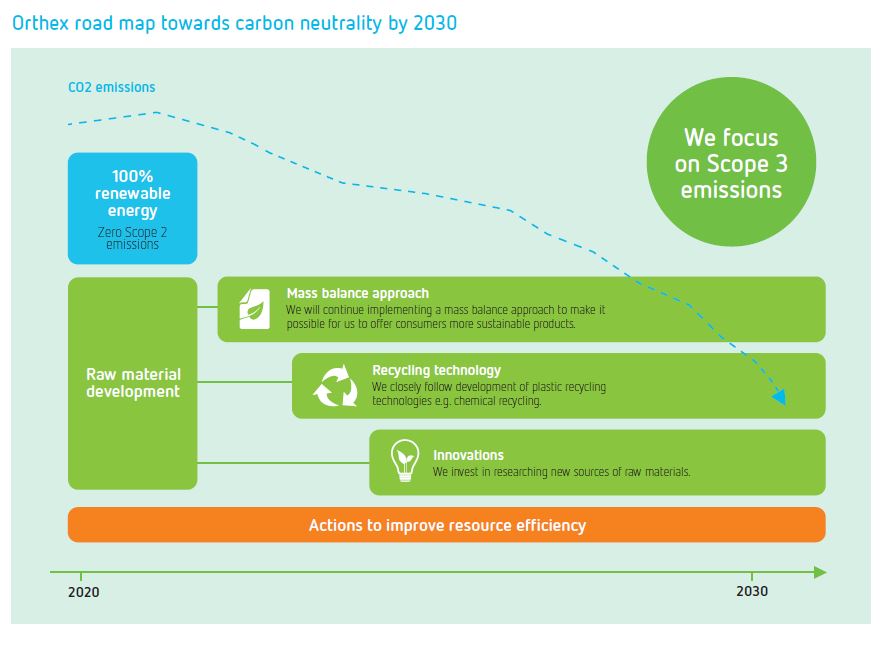Carbon footprint
Reducing greenhouse gas (GHG) emissions and increased sourcing of recycled and renewable raw materials are at the core of our strategy and sustainability vision.
We have calculated carbon footprint of our operations and value chain and simulated our road map towards carbon neutral production taking into account Scope 1, 2 and 3 emissions.
Orthex is committed to reducing its greenhouse gas emissions and is aiming towards carbon neutral production by 2030.
Carbon footprint of our operations and value chain
We have calculated the carbon footprint of our operations and value chain since 2020. In addition to direct greenhouse gas emissions from our operations (Scope 1) and the production of purchased energy (Scope 2), we included the following indirect emissions (Scope 3) in our calculation: purchased goods and services; fuel and energy-related activities; upstream transportation and distribution; waste generated in operations; and end-of-life of sold products.
The emission factors used in the market-based calculation of Orthex’s carbon footprint are based on widely used and trusted sources, such as the licensed databases of Ecoinvent and Sphera. When primary data from our suppliers is not available, average emission factors are used. In 2024, updates were made to these databases including more detailed data on fossil supply chains and improved information on related methane leaks. Consequently, the plastic emission factors, and related emissions increased. To maintain data comparability, we have updated the previous years’ CO2 calculations with the updated emission factors.
Most of our greenhouse gas emissions originate from purchased goods and services, such as raw material extraction, and the end-of-life of sold products, such as the incineration of products for energy. The latter is excluded from our 2030 carbon neutrality target. This is because of our limited ability to influence consumer behaviour – whether they recycle or discard our products after use – but also because it is difficult to evaluate how the recycling of plastic develops.
As our products will be in use for decades, it is likely that by the time they reach their end-of-life stage, most plastic will be fully recycled. This, and future chemical recycling, will significantly reduce the greenhouse gas emissions from the end-of-life stage of plastic products.

The raw material has the biggest impact on the carbon footprint of the products. It is therefore increasingly important to increase the use of recycled and renewable raw materials in the production to reduce the carbon footprint of products. This is a key goal in our strategy. It is very important for companies and consumers to recycle all the plastic they use, since it can be re-used many times as raw material for new products. Read more about recycling of our products and packaging materials.
Road map towards carbon neutrality by 2030
We have set an ambitious target and are aiming towards carbon neutrality in our production by 2030. In 2022, we simulated our road map towards carbon neutrality, taking into account Scope 1, 2 and 3 emissions. In 2021, we took a significant step and replaced fossil-based electricity with renewable electricity in all our factories. This action enabled us to reduce our Scope 2 emissions to zero.
As almost all our remaining emissions originate from the raw materials (Scope 3), we focus our efforts on increasing the share of renewable and recycled raw materials in our production. Key drivers enabling us to move towards our goal are: further adoption of the mass balance approach, innovations, new sources of raw materials, and development of plastic recycling technology.
In 2022, Science-Based Targets initiative (SBTi) approved Orthex’s near term science-based emissions reduction target, which means that our climate targets are aligned with the target to keep global warming below 1.5°C in accordance with the Paris Agreement.



 Storage
Storage  Kitchen
Kitchen  Home & Yard
Home & Yard  Plant care
Plant care  Renewable & recycled
Renewable & recycled 

